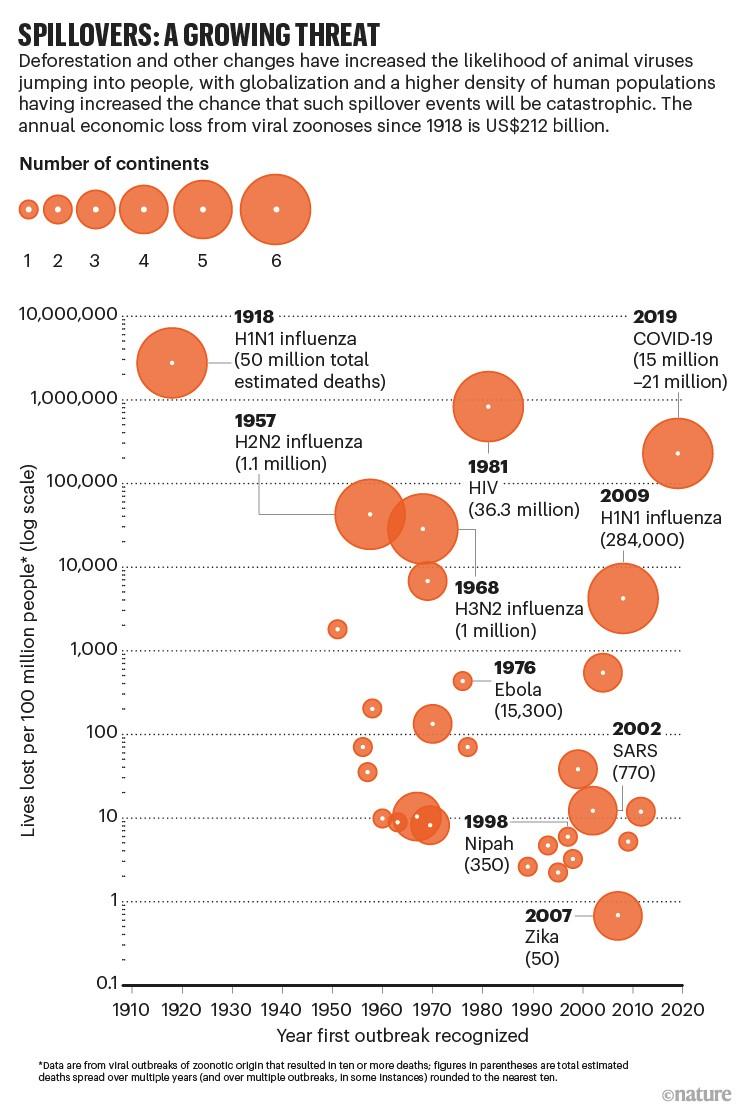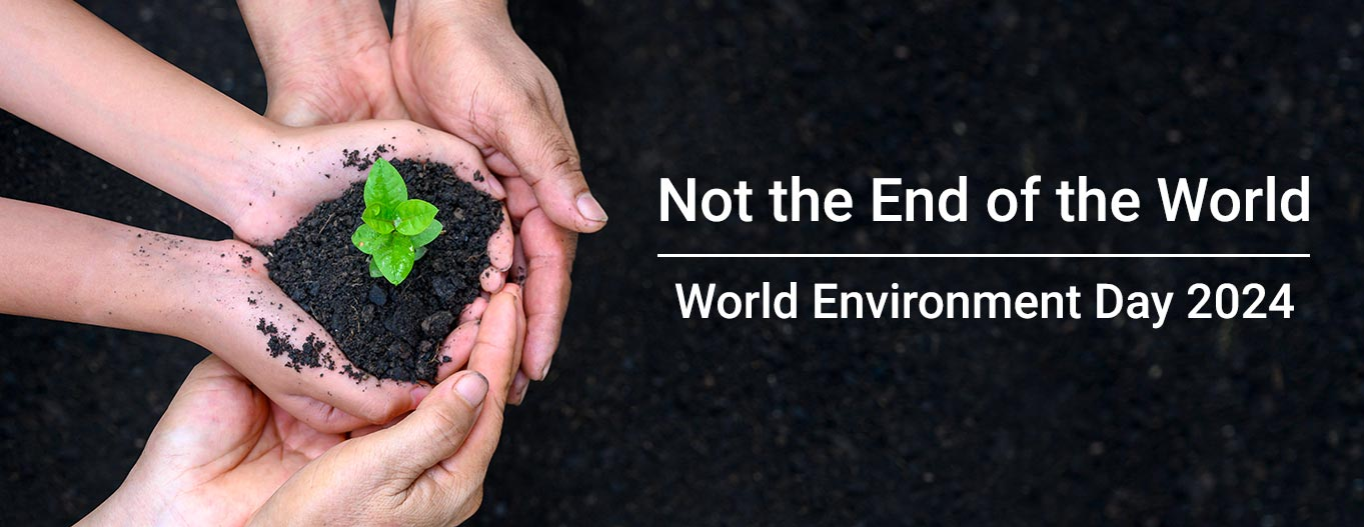
This article is a part of the essay series: Not the End of the World: World Environment Day 2024
Environmental factors play a major role in human health, with direct and indirect impacts on the economy and society. For example, in India, severe droughts of 1987 and 2002 hit vast regions, causing water scarcity and crop failure, leading to widespread malnutrition and increased disease burden. Similarly, the Dust Bowl, between 1930 and 1940, devastated the United States with drought and persistent dust storms, exacerbated by poor land management, leading to increased respiratory disorders, measles cases, and higher mortality rates.
The 1994 plague outbreak in Surat, India, linked to poor waste management and environmental degradation, highlights the critical connection between ecosystem, health, and disease. When land is degraded and ecosystems are disrupted, the balance of nature is disturbed, leading to the spillover (Figure 1) of zoonotic diseases due to closer human-animal interactions. Deforestation, habitat loss, and agricultural expansion also push wildlife into closer contact with humans, increasing the risk of disease transmission. In addition, desertification and drought amplify food and water insecurity, leading to malnutrition and weakened immune systems, making populations more vulnerable to diseases. By restoring land and building resilience against drought, these health risks can be reduced and healthier environments can be created.
Figure 1: Spillovers: A Growing Threat across the World

Source: https://www.nature.com/articles/d41586-022-01312-y
The World Environment Day on 5 June is an opportunity to focus on the critical themes of land restoration, drought resilience, and desertification, major challenges that are connected with public health through multiple pathways. The One Health framework, which considers the health of humans, animals, and ecosystems together into a unified system, provides a useful perspective for understanding and addressing these complex issues.
Land restoration and public health
Land restoration involves rehabilitating degraded lands to improve biodiversity, soil fertility, and water retention through appropriate methods, which can significantly contribute to mitigating the impacts of drought and desertification. Successful land restoration projects often involve re-forestation, sustainable agricultural practices, and the revival of natural water sources as well. Initiatives in India’s arid regions, such as those led by some NGOs, have demonstrated how traditional water harvesting techniques like johads (small earthen check dams) can rejuvenate land and support local communities. Such initiatives have revitalised dry riverbeds and improved groundwater levels, transforming barren lands into fertile areas.
Land restoration involves rehabilitating degraded lands to improve biodiversity, soil fertility, and water retention through appropriate methods, which can significantly contribute to mitigating the impacts of drought and desertification.
Restoring land also has clear implications for public health. Healthy ecosystems can act as buffers against the spread of infectious diseases by maintaining natural habitats that support a balanced wildlife population. When ecosystems are disrupted, pathogens can more easily jump from animals to humans, especially seen in regions prone to drought and desertification. By investing in land restoration, healthier environments can be created that are less conducive to disease outbreaks. The Eco-Task Force of the Indian Army has undertaken afforestation projects in Uttarakhand, which has not only enhanced local biodiversity but also has reduced human-wildlife conflict, thus contributing to public health and environmental stability. Studies have shown that restoring natural habitats reduces the contact between wildlife and human populations, thereby lowering the risk of zoonotic spillovers.
Land restoration projects often incorporate community involvement, ensuring that local populations benefit from improved agricultural productivity and enhanced resilience to climate change. This community-centric approach fosters sustainable development and also strengthens social cohesion and public awareness about the importance of environmental stewardship. In this way, land restoration serves as a bridge between ecological health and human well-being, highlighting the multifaceted benefits of sustainable land management.
Examples from across the world, such as the rapid restoration observed on China’s Loess Plateau and the success of the Great Green Wall initiative in Africa, demonstrate that land restoration can yield quick and tangible benefits, including health ones. These projects have led to increased water availability, enhanced vegetation cover, and a return of native biodiversity within a short period of implementation, proving the effectiveness and immediate impact of restoration efforts. Restored lands enhance public health by improving air and water quality, boosting food security and nutrition, supporting mental well-being, reducing urban heat, and mitigating natural disasters.
Drought resilience: A multi-pronged approach
Drought resilience is crucial for sustaining both agricultural productivity and public health in the face of changing climate patterns. Traditional farming techniques when they are coupled with innovative technologies can enhance water efficiency and crop resilience. For example, drought-resistant crop varieties and advanced irrigation methods can help farmers maintain yields despite water shortages. These practices secure food supplies and nutritional security as well as reduce the economic and social stresses associated with drought.
Building drought resilience also involves protecting and restoring natural water sources such as rivers, lakes, and wetlands. These ecosystems play a vital role in maintaining the water cycle and supporting biodiversity. Efforts to revive water bodies can include measures like reforestation of catchment areas, preventing pollution, and creating buffer zones to reduce runoff. Such initiatives help maintain water availability during dry periods, benefiting both human populations and wildlife.
Building drought resilience also involves protecting and restoring natural water sources such as rivers, lakes, and wetlands. These ecosystems play a vital role in maintaining the water cycle and supporting biodiversity.
The health impacts of drought extend beyond food and water insecurity. Prolonged drought conditions can lead to malnutrition, respiratory problems due to dust storms, and mental health issues stemming from economic hardship. By enhancing drought resilience, these health risks can be mitigated and more resilient can be communities built. It is essential to adopt a holistic approach that combines environmental management with public health strategies, ensuring that drought resilience efforts address the broad spectrum of impacts associated with water scarcity.
Combating desertification: An urgent need
Desertification, the process by which fertile land becomes desert, is another threat exacerbated by climate change. It leads to the loss of productive land, reduces biodiversity, and disrupts local economies. Combating desertification requires a combination of prevention, mitigation, and restoration strategies, using techniques such as afforestation, sustainable land management practices, and the use of drought-resistant vegetation which are critical in halting and reversing it.
Preventing desertification also has direct benefits for public health. Degraded lands are more prone to dust storms, which can cause respiratory problems and accelerate the spread of pathogens. Additionally, the loss of arable land can lead to food shortages and malnutrition, affecting immunity. By stabilising soils and restoring vegetation, we can improve air quality, enhance food security, and create healthier living conditions for affected communities. These efforts are crucial for building resilience against the multifaceted impacts of desertification.
Preventing desertification also has direct benefits for public health. Degraded lands are more prone to dust storms, which can cause respiratory problems and accelerate the spread of pathogens.
Global collaboration and knowledge sharing are vital in the fight against desertification. Countries facing similar challenges can learn from each other's experiences and implement best practices tailored to their specific contexts. International frameworks, such as the United Nations Convention to Combat Desertification (UNCCD), provide valuable platforms for coordination and support. By working together, nations can develop and implement more effective strategies to combat desertification, ensuring that efforts are synergistic and comprehensive.
The way forward
This World Environment Day, various stakeholders including governments, the private sector, and communities must acknowledge and take action on the urgent need to accelerate land restoration, improve drought resilience, and combat desertification. These efforts are crucial for environmental sustainability and for safeguarding public health. The “One Health” approach provides a holistic framework for understanding and addressing these interconnected challenges, and by integrating environmental and health strategies, we can create a more resilient and sustainable future for all. Through collaborative efforts and innovative solutions cutting across various sectors and disciplines, we can protect our planet and improve the health and well-being of communities worldwide.
Oommen C. Kurian is a Senior Fellow and the Head of Health Initiative at the Observer Research Foundation.
The views expressed above belong to the author(s). ORF research and analyses now available on Telegram! Click here to access our curated content — blogs, longforms and interviews.




 PREV
PREV

.png)
.png)
